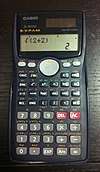Casio BASIC
Casio BASIC is a programming language used in the Casio calculators such as the Classpad, PRIZM Series, fx-9860G Series, Algebra FX and CFX graphing calculators.
The language is a linear structured, BASIC-based programming language. It was devised to allow users to program in commonly performed calculations, such as the Pythagorean theorem and complex trigonometric calculations.
Output from the program can be in the form of scrolling or located text, graphs, or by writing data to lists in the calculator memory. Casio also makes label printers which can be used with rolls of paper for the Casio BASIC calculators.[1] Programs, variables, data, and other items can be exchanged from one calculator to another (via SB-62 cable) and to and from a computer (via USB cable). All new models of Casio graphing calculators have both ports and include both cables.
The Casio calculators, as with those of many of the other big three manufacturers' machines, can acquire data from instruments via a data logger to which probes for temperature, light intensity, pH, sound intensity (dBA), voltage and other electrical parameters, as well as other readings, and custom probes to attach to the data logger [2] can be built and configured for use with the data logger and calculator. Existing instruments can also be modified to interface with the calculator-data logger, in order to collect such data including such things as weather instruments and means of collecting data such as pulse, blood pressure, galvanic skin resistance, EKG and so on.
Numerical data can be stored in the lists and matrices available on Casio calculators. This data can be used to create sprites for non-text programs.[3] In this way, the language can also be used to create games, such as Pong, Monopoly and role-playing games.
Examples
Hello world in casio BASIC:
"Hello World!"
variables:
5->a
Loops:
label 1
"forever!"
goto 1
References
- Casio CFX-9850 PB Users' Manual, Chapter 21
- Casio CFX-9850 PB Users' Manual, Chapter 17
- "Casio BASIC matrix sprite tutorial". Archived from the original on 2014-05-19. Retrieved 2014-05-19.
External links
- A tutorial for making games with Casio BASIC: http://community.casiocalc.org/topic/2448-casio-basic-tutorial/
- A source for games and programs written in Casio BASIC. (Not tested/verified): http://cabbresson.tripod.com/Casio/CasioIndex.htm
See also
